SpaceX launches three payloads
SpaceX yesterday successfully launched three different payloads on its third “Bandwagon” launch, its Falcon 9 rocket lifting off from Cape Canaveral.
The first stage completed its third flight, landing back at Cape Canaveral. The fairings completed their second and fifteenth flights respectively.
The rocket’s primary payload was a commercial satellite for a South Korean company. Next was a commercial weather smallsat from the startup Tomorrow.
The third payload was from the European company Atmos, and was intended to test its deployable heat shield designed to protect payloads returning from orbit. According to the company, preliminary data says the deployment and return went as planned.
The leaders in the 2025 launch race:
46 SpaceX
20 China (with a launch scheduled for this morning)
5 Rocket Lab
5 Russia
SpaceX now leads the rest of the world in successful launches, 46 to 35.
SpaceX yesterday successfully launched three different payloads on its third “Bandwagon” launch, its Falcon 9 rocket lifting off from Cape Canaveral.
The first stage completed its third flight, landing back at Cape Canaveral. The fairings completed their second and fifteenth flights respectively.
The rocket’s primary payload was a commercial satellite for a South Korean company. Next was a commercial weather smallsat from the startup Tomorrow.
The third payload was from the European company Atmos, and was intended to test its deployable heat shield designed to protect payloads returning from orbit. According to the company, preliminary data says the deployment and return went as planned.
The leaders in the 2025 launch race:
46 SpaceX
20 China (with a launch scheduled for this morning)
5 Rocket Lab
5 Russia
SpaceX now leads the rest of the world in successful launches, 46 to 35.





